
National Grid History
National Grid's history in the United States stretches back to the early electric generating companies at Niagara Falls in the early 1880s. As generating technology improved and electric companies adopted alternating current, hydropower lit up the streets of nearby Buffalo in 1896. Hydropower use spread throughout the state and by the end of the 1920s, 59 different electric utilities served the energy needs of northern New York state by generating power from New York's major rivers, the Hudson, Mohawk, and Niagara.
In 1929, the three utility holding companies that controlled these 59 utilities merged them to form the Niagara Hudson Power Corporation. From that, its three subsidiary regional utility companies powered upstate New York customers. But over time, increasing demand forced the company to become more centralized. In 1950, it reorganized into the Niagara Mohawk Power Corporation.
Tough economic conditions in the 1990s forced Niagara Mohawk to sell off all of its generation assets. By 2000, it became an electricity transmitter and distributor. Leaner and much more profitable, it attracted the interest of the British company, National Grid PLC. In Sept, 2000, National Grid bought Niagara Mohawk for $8.9 Billion, completing the full merger in 2002.
National Grid supports programs designed to help improve the way people live, work and play across their service territory. Their corporate giving invests in community programs that meet their focus areas of education, energy and environment.
National Grid Service Territory
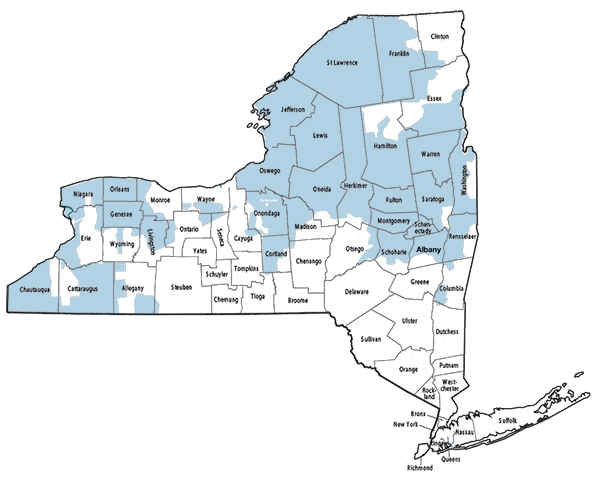
National Grid serves 1.6 million electric customers in more than 450 cities and towns in some or all of these upstate New York counties:
| Albany | Allegany | Cattaraugus | Cayuga | Chautauqua |
| Chenango | Clinton | Columbia | Cortland | Erie |
| Essex | Franklin | Fulton | Genesee | Hamilton |
| Herkimer | Jefferson | Lewins | Livingston | Madison |
| Monroe | Niagara | Oneida | Onondaga | Ontario |
| Orleans | Otsego | Renselaer | Saratoga | Schenectady |
| Schoharie | St. Lawrence | Warren | Washington | Wyoming |
National Grid serves these cities:
Shop National Grid Electricity Suppliers In Your Area.
Compare National Grid Electricity Rates
Compare alternative supplier electricity rates
in the National Grid service area.
- Enter zip code.
- Select "electricity".
- Choose "residential" or "business".
- Click "Shop for Rates".
In New York, electricity utility service territories may overlap in some zip codes. If the tool reports that it has found more than one serving your zip code, don't worry! Just choose your local utility from those listed.
You'll then get to see the listing of all the energy suppliers' plans available in your area, along with rates, term lengths, and links to more detail information.
How to Start New National Grid Service
Getting set up with National Grid is easy and convenient. Just visit the National Grid web site to start your electric service. If you don't have an account, you can start one there and then follow the prompts to set up your service.
Customers can also apply to start service by calling National Grid customer service (1-800-642-4272 ).
Be ready to supply:
- Service Address: The address where you want your service turned on or switched.
- The start date for electricity service.
- Personal Information: You will need to provide a valid form of identification (such as a driver's license or credit card) to validate your name and prior address. Otherwise, you will need to pay a deposit.
- The utility may also require proof of your occupancy date for service and ask you for a copy of your lease or deed.
Applicants for electric service must have paid in full all bills on their past National Grid accounts or agree to a deferred-payment plan before a new account can be opened. National Grid will notify you by letter within three business days after receiving your application if it has been denied. The letter will state the reason(s) for denial, exactly what you must do to be approved.
Will I Need to Pay a Deposit?
In New York, no utility can require any new residential customer to pay a security deposit as a condition of receiving utility service.
However, the utility can require a deposit if:
- You're new seasonal or short-term customer.
- Existing customers that made two or more late payments within a 12-month period, or are experiencing financial problems (for example, employment or debt problems ) will likely need to pay a deposit.
- The customer was previously disconnected or has unpaid energy bills during the preceding six months.
Note: If you're aged 62 or older or you are receiving public assistance, supplemental security income, or additional state payments then you will not need to pay a deposit.
If you must pay a deposit -- National Grid must notify you in writing within 3 business days about the specific reasons why you are required to pay a security deposit. NY law states that deposits cannot be greater than an estimated two months usage.
Customers have 20 days after the utilty sends the deposity request notification to make a payment. However, customers can pay the full deposit in installments over a 12 month period. National Grid can hold deposits for residential service for 12 months. If the customer pays their bill in full and on time for 12 consecutive months, the deposit will earn interest.
Understand National Grid Delivery and Supply Charges
In New York, residential customers pay for both the cost to deliver their electricity as well as for the amount of electricity supply that they use.
Understand National Grid Zone Charges
New York State is a complicated place to supply and distribute electricity. For the that reason, the New York Independent System Operator (NYISO) operates New York's bulk electricity grid, administers the state's wholesale electricity markets, and provides comprehensive reliability planning for the state's bulk electricity system.
To keep the power flowing smoothly all across New York State, NYSIO has divided it into 11 load zones, labeled A through K.
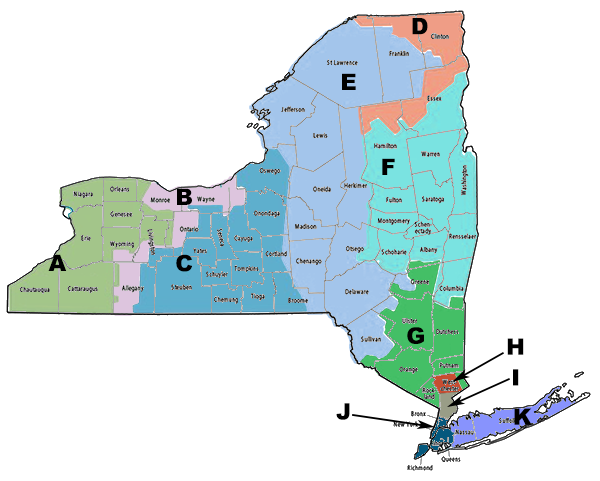
These load zones directly affect your electricity rates:
- New York electric utilities can operate in more than one load zone. For example, National Grid serves zones A, E, and F, as well as towns and cities in B, C, and D.
- Both supply and delivery rates can be different in each zone. That means the rates you pay for your electricity will depend on which zone you live in.
What Are National Grid PTC Charges?
When deregulation began in New York, all utilities that wanted to participate in consumer choice had to sell off their generators. However, the NY PSC requires these utilities to provide electricity supply at a default rate to customers in their service territory who don't shop for a retail supplier. As a result, these utilities must purchase their electricity supply for the default rate from generator companies.
The NY PSC oversees National Grid's default service rates since these represent generation supply costs that are passed directly through the utility onto their customers without mark up. This default rate is also called the "Price to Compare" or PTC.
Price to Compare (PTC)
The PTC default rate represents the actual price (generation + transmission) the utility pays for the electricity. In other words, it not only includes the generator company's price for making the electricity but also the cost to transmit it from power stations over high tension power lines to National Grid's local electrical switch yards. From there, the electricity is distributed throughout the National Grid local electrical grid for delivery to homes.
National Grid's PTC rate is composed of the Supply charge. This rate is based upon market conditions during the billing period and will vary depending on where you live or do business. It changes monthly. There are also other charges which include the Merchant Function Charge, the Clean Energy Standard Supply Surcharge, the Electricity Supply Reconciliation Mechanism, and other surcharges.
Because electricity demand fluctuates due to seasonal weather, National Grid's Supply charge rates can vary seasonally; low some months, higher the next -- especially in summer when air conditioning usage can soar. You can never be too sure what you'll pay from one mnth to the next.
National Grid Current PTC Standard Residential Rate:
- 10.680 cents per kWh, Zone A, expires 9/30/2025
- 10.680 cents per kWh, Zone C, expires 9/30/2025
- 10.680 cents per kWh, Zone E, expires 9/30/2025
- 10.680 cents per kWh, Zone F, expires 9/30/2025
How Much Do National Grid Charges Cost?
The US Energy Information Agency reports that in 2019 New York State's residential customers used an average of about 577 kWh each month.
Therefore, an average residential PTC bill in Zone C roughly breaks down like this:
| Rate per 577 kWh Used | Monthly Customer Charge | Total | |
| PTC Supply Rate, Zone C (excluding MFC and other surcharges) |
10.680 cents | 0 | $61.62 |
| Monthly Distribution Charges (non-summer rate, excluding riders) |
$0.06143 per kWh | $17.00 | $52.44 |
| Total Bill | $114.06 |
Understand New York Energy Choice
New York electric consumers are free to choose to buy electricity from Energy Service Companies (ESCOs). These alternative suppliers shop deals with different electricity generators on the wholesale market to offer competitive rates. As such, their rates are not controlled by NY PSC nor do they include the same complicated supply surcharges that National Grid does in its monthly PTC rate. This way, ESCOs are able to offer competitively priced fixed rate plans for a variety of term lengths.
Though it can seem confusing, shopping electricity plans is an easy process. The trick is finding the one that meets your needs. That's why retail energy suppliers in New York offer two types of plans:
Your Energy Usage and Your National Grid Bill
While your energy usage habits are unique to you, any upstate New York native will tell you that winters can be bitterly cold upstate and summers can be hot, hazy, and humid. While your biggest energy usage will usually follow the weather, all those other domestic activities, like cooking and cleaning, also add to your monthly bill.
- While most NY homes rely on natural gas for heating, only 12.2% of homes in the state rely on electricity for heat.
- New York residents spend on average 5% of their annual energy costs on air conditioning. About 53% of NY households have window or wall-mounted AC systems while only 20% have central AC.
- Approximately one third (32%) of home electricity usage goes to electronics, lighting, appliances, and air conditioning.
- The remainder of energy use goes to water heating, refrigeration, lighting, electronics, clothes dryers, cooking, and small appliances.
Want to learn more about your home energy usage? National Grid customers can track 24 months of their home's electric usage plus other relevant information on each monthly bill or by logging on to your National Grid account.
The most effective way to cut your energy bills is to reduce your usage by sealing your doors and windows against winter and summer drafts. Adding insulation to your attic, sealing and insulating your basement, and purchasing a programmable or smart thermostat also improve your home's energy efficiency and help cut your electric bills. Your utility company can provide a wealth of resources and may offer programs to help you improve your home's energy performance.
Understand Your National Grid Bill
Your National Grid bill contains many details that can be confusing to customers. But there's lots of useful information to help you better understand your usage and rate. Below, we break down the most important items on a sample National Grid Electric bill.
National Grid Sample Bill
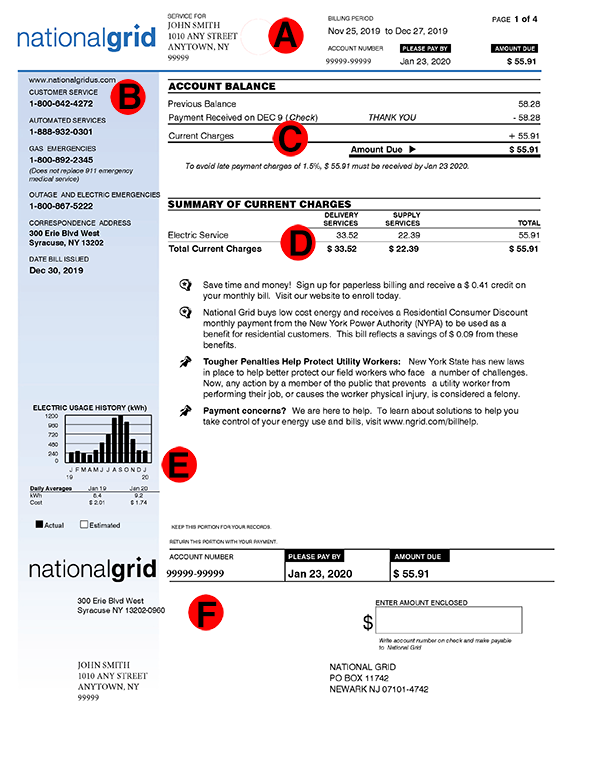
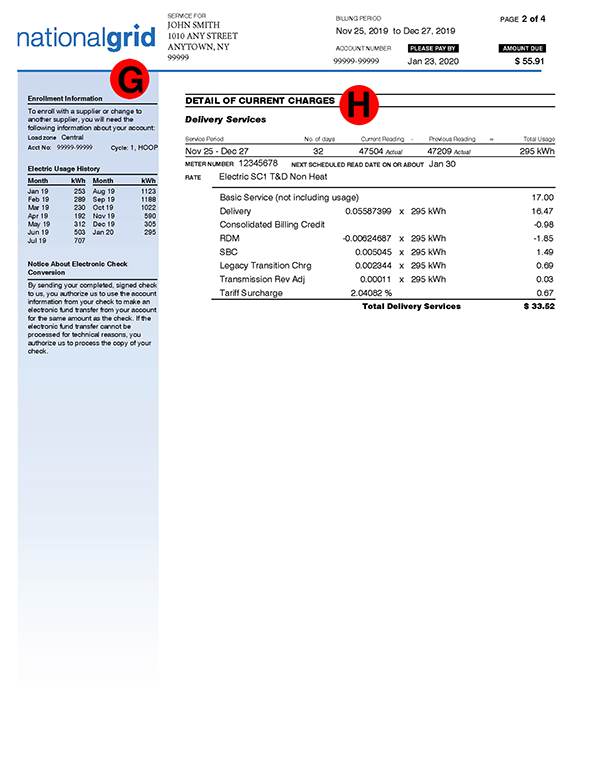
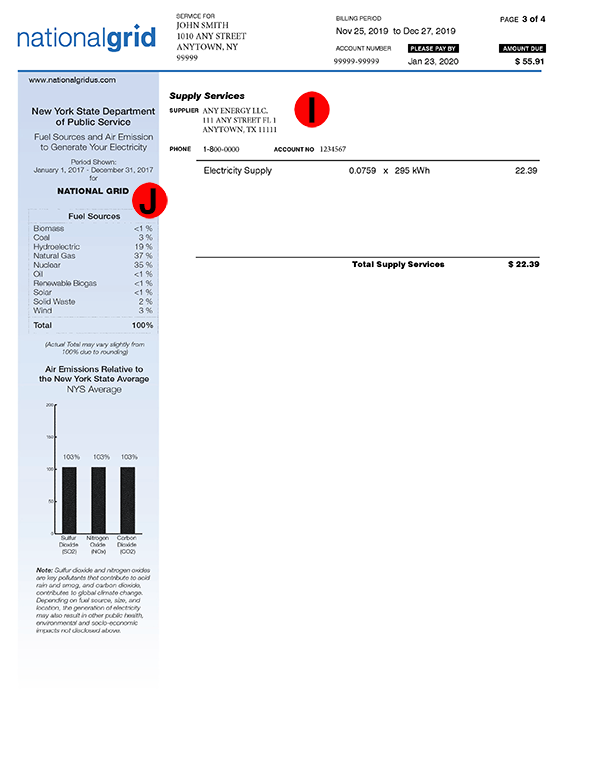
- A: Billing Information. Beginning on the left, this section shows your name, 10 digit National Grid account number, service address, the date that the payment is due and the amount due.
- B: Contact Info and Bill Date. This section lists National Grid contact information for customer service, emergencies, and outages. It also shows the date the bill was issued.
- C: Account Balance. This section shows your previous balance due, the payments received, and the current charges.
- D: Summary of Current charges. Here you can find the current delivery charges for your electric service and also the current charges for your electricity supply.
- E: Electric Usage History. Here you can find your electricty usage rate for the past 12 months as well as a comparison to the same period last year.
- F: BIll Payment Stub. This shows your 10 digit National Grid account number, the bill due date, and the amount due. The section below shows the mailing address should you pay your bills by mail.
- G: Page 2, Enrollment Information. This begins on the left side with your Enrollment Information. When you sign up with a New York energy supplier, you need to provide them your loadzone, your 10-digit National Grid account number, and your billing cycle information. Next, below this section, is a breakdown of your electric usage history for the year showing your monthly usage amount. This can be very helpful in planning your budget for the year.
- H: National Grid Delivery Charges. This section shows a detailed breakdown of your electricity delivery charges for the current service period. It includes specific information on your rate-type, basic and delivery charges, and surcharges. It also show when the next meter-reading will be.
- I: Page 3, Electriticy Supplier Charges. Shows the name of your Energy Service Company and their contact information. It also shows the amount of electricity you consumed, the rate in kilowatt hours (kWh) that your are being charged, and the total amount due for that supply.
- J: Fuel Sources. This section breaks down the generation fuel sources and emissions involved in generating your electricity during the month. In New York, natural gas, nuclear, and hydorelectric dams provide that bulk of electricity.
Compare National Grid Rates
National Grid Coupons, Energy Promotions, Discounts, Rebates and Promo Codes
As your local electric utility, National Grid offers several rebate and energy efficiency programs to help customers save money off their monthly bill by upgrading their home's energy performance. Some programs also offer money-saving incentives while others could make paying your monthly bills much easier during those expensive winter and summer months.
| Program Name | Program Type | Benefit |
| HVAC Rebates Program | Energy Efficiency Rebate Program | National Grid residential customers can take advantage of significant rebates on the purchase of high efficiency heating and cooling systems, including geothermal, heat pumps, central air conditioning, ductless systems, and water heating.
|
| Appliance Rebate Program | Energy Efficiency Rebate Program | Appliances include energy-saving LED bulbs, water heaters, washers, dryers, refrigerators, freezers, ventilation fans, and dehumidifiers. Rebates range from $25 to $400. National Grid residential customers can get rebates by shopping the online National Grid Marketplace. |
| Residential Energy Assessment & Upgrades | Energy Efficiency Program | Qualifying National Grid customers can receiver generous rebates to help improve your home's energy efficiency.
|
| Em-Power New York Energy Efficiency Upgrades | Residential Energy Efficiency | National Grid has partnered with New York State Energy Research and Development Authority to provide no-cost energy efficiency upgrades to eligible National Grid customers to reduce their electric bills.
|
| National Grid Payment Arrangements | Bill payment assistance | National Grid offers payment arrangements to allow residential customers to pay their account balance in monthly installments. These installments are billed along with your current monthly charges and both must be paid on time, in full each month.
|
| National Grid Energy Care and Share | Bill payment assistance | If you're a residential customer with an active disconnect notice, you may qualify for up to $200 toward your bill once every three years. Applicants must be HEAP income eligible and provide proof of one good faith payment in the last twelve months. |
| Low Income Grant | Bill payment assistance | National Grid works with many regional programs to help low income families receive a grant to pay their bills if they are enrolled in an elligible program. Customers who qualify for the electric low income rate receive a reduction to the basic service charge. These programs include:
|
Read National Grid Reviews
Since National Grid serves a large east coast market segment, uptstate residential customers can get a better picture of how good a job it does by comparing it to similar large-scale utilities. While National Grid is not accredited with the BBB, the utility ranks within the average range for J.D. Power's 2020 utility residential customer satisfaction study.
| NY Energy Ratings Score | Better Business Bureau | J.D. Power 2020 Electricity Utility Study |
| N/A | Not Accredited, A- |
722 of 1000 pts |
How Do I Get the Cheapest National Grid Rate?
Shopping for a new National Grid Customer Choice Plan can seem bewildering at first. Once you understand how it works, though, it's an easy and straightforward process. That said, you should have these three things with you when you shop for electricity.
- Your current bill. Your past usage per billing period can help you estimate a how much a plan might cost you each month.
- The current National Grid PTC rate. Knowing the current National Grid supply price lets you compare rates offered by retail energy suppliers. This way, you can get a better feel for what suppliers are offering, for how long, and if any of their incentives make their price work for your family's need.
- Your National Grid customer account number. You'll also need your load zone, billing cycle information. These are found with your This 10 digit account number on page 2 of your bill. Having these handy lets you sign up with a retail supplier right away.
National Grid Shopping Questions
The best way for a NY energy customer to avoid making a bad choice it to ask the right questions. That way, you can learn exactly the information that can save you money. When you shop for electricity service in New York, always be sure to ask these important questions:
- Is the rate variable or is it fixed?
- Is the rate competitive with the current National Grid supply rate? National Grid's rate changes monthly!
- How long does the plan contract term run?
- Does the plan's contract term last longer than National Grid's PTC rate?
- Does the plan include any recurring monthly charges?
- Does the plan have an early cancellation fee?
- Does the supplier offer any customer incentives or rewards programs?
- What happens when the contract expires?
Other Commonly Asked New York Electricity Questions:
Who bills me? National Grid sends a single bill that outlines and adds up your monthly charges.
What are the Terms of Service? In NY, Customer Choice Plans must include Terms of Service that explain and identify specific charges and any fees a customer will face when they sign up for an electricity plan. Not all suppliers have the same terms. That's why all New York energy choice customers should read and understand the terms of service and contract summary for any plan they are interested in before they sign on to the plan.
What is the Right of Rescission? According to the New York ESCO Consumers Bill of Rights, residential customers have the right to rescind or cancel an agreement with an ESCO within three days of receiving the agreement without facing a penalty.
What are early termination fees? Switching retail suppliers before a contract ends can involve paying early termination fees. These can take a big chomp out of your checking account you if choose to switch retail providers before your plan contract ends.
Where can I find more information on my usage? National Grid customers can request 24 months of their energy usage free of charge. This is most easily available through your National Grid online account.
Read National Grid Customer Reviews
Compare National Grid Electricity Rates in Your Area
Bill Questions? Electricity Out? Contact National Grid!
Having problems or interruptions with your National Grid electricity? Here's the proper people to call.
National Grid Billing Problems
The NY PSC requires all New York public utilities to offer "budget billing" where annual electricity costs are averaged out over the cost of the year. This ensures that customers aren't presented with unexpectedly high bills at peak times.
- First thing to do is contact National Grid. If you are having trouble paying your monthly bill call National Grid's Customer Service: 1-800-642-4272 . Have your account number ready. You can also apply online through your National Grid account.
- Need extra time to pay your energy bill? Customers can apply for a payment extension. Call National Grid Customer Service or by applying on-line.
National Grid Emergencies and Outages
All power lines are extremely dangerous! Never attempt to move a downed power line by yourself. Call 911 and then notifiy National Grid.
- Report downed powerlines and other safety hazards immediately to National Grid at 1-800-867-5222.
- You can also report downed lines or outages at National Grid's website.
- Check National Grid's current electric outages as they are being repaired.
National Grid Service Area Providers
| Company | Rating | Phone |
|---|---|---|
| Frontier Utilities | (3.4/5) |
|
| Direct Energy | (3.3/5) |
(866) 645-2643 |
| Constellation | (3.3/5) |
855-798-9075 |
| Spark Energy | (3/5) |
(866) 605-8658 |
| Major Energy | (2.9/5) |
(866) 607-4735 |
| Verde Energy | (2.8/5) |
|
| APG&E | (2.5/5) |
866-606-2584 |
| Kiwi Energy | (0/5) |
|
| Spring Power & Gas | (0/5) |
|
| 9 results | ||
New York Zip Codes with the Cheapest Electricity Rates
The Latest National Grid News
Save a Ton with 4th of July Appliance Deals Save ton on your energy bills when you shop energy saving appliances this July 4. Check out utility rebates and tax credits that help you save... [read more]
Shop the Cheapest Electricity in Albany Shopping for the Cheapest Electricity plan can be confusing. We sort through the nagging questions to help you find the best deals. If you’re a new... [read more]
Winter Prep Tips for Albany Home sure, fall's just starting. But learn which important winter prep chores you can do easily while it's still warm! Plus you''ll find ways to save more on your... [read more]